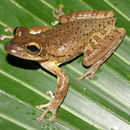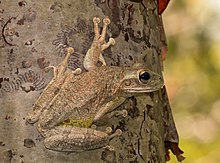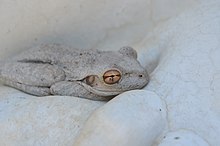en
names in breadcrumbs


Average lifespan
Status: captivity: 12.9 years.
This is the largest of the American tree frogs. Males generally have a maximum size of 5.1-6.3 cm (SVL), with females being much larger, attaining a size of 12.7 cm (SVL). Osteopilus septentrionalis is highly variable in color, but they are usually some shade of gray, tan or olive, occasionally with dark, marbled blotches dorsally. Their skin is very textured, and they have extremely large eyes and toe pads (Bartlett, 1996).
Other Physical Features: ectothermic ; bilateral symmetry
Typical of tree frogs, O. septentrionalis spends most of its time in trees or very large plants, especially those with large leaves.They are found only where low temperatures stay above 10 degrees C, with daytime temperatures between 23-29 degrees. This species also prefers areas of high humidity, thus it is very common along waterways. As O. septentrionalis has been introduced, it has become particularly abundant around the pool areas of hotels, where the comination of large decorative vegetation and abundant food resources have made for a favorable habitat (Bartlett,1996).
Terrestrial Biomes: forest
Osteopilus septentrionalis is native to Cuba and nearby islands. it has also been introduced throughout the Caribbean and into southern Florida (Bartlett, 1996).
Biogeographic Regions: nearctic (Introduced ); neotropical (Introduced , Native )
Other Geographic Terms: island endemic
Osteopilus septentrionalis is a voracious predator, and will eat almost anything they can fit in their mouths. They are generally insectivorous, feeding mainly on large cockroaches and moths. however, large adults are known to consume everything from small lizards and snakes to young mice and even hatchling birds (Bartlett, 1996).
Osteopilus septentrionalis does not appear to have much of an impact on human beings, aside from a very small representation in the American pet trade.
This species has been widely introduced throughout the Caribbean and into southern Florida, and appears to be having a negative impact on the ecosystems it is invading. It has been observed that in the areas of introduction, there has been a marked decrease in the populations of native tree frogs, probably due to predation and competition for resources (Bartlett,1996).
Development - Life Cycle: metamorphosis
Currently, numbers of Osteopilus septentrionalis appear to be on the rise. They appear to be doing especially well in urban residential areas, and are spreading very rapidly throughout the Caribbean. This does not bode well for native species of tree frog, which don't appear to be able to compete with O. septentrionalis.
IUCN Red List of Threatened Species: least concern
This species reproduces in late spring, as temperatures climb into the range of 27-29 degrees C. Males typically establish some kind of territory in a pond or flooded ditch, and call to females with vocalizations consisting of clucks, growls and squeaks. Mating occurs via inguinal amplexus, and eggs are laid in scattered masses underwater.
Key Reproductive Features: gonochoric/gonochoristic/dioecious (sexes separate)


The Cuban tree frog (Osteopilus septentrionalis) is a large species of tree frog that is native to Cuba, the Bahamas, and the Cayman Islands; but has become invasive in several other places around the Americas.[3] Its wide diet and ability to thrive in urban areas has made it a highly invasive species with established colonies in places such as Florida,[4] the Hawaiian island of Oahu, and the Caribbean Islands.[5] These tree frogs can vary in size from 2 to 5.5 inches (5 to 12.7 cm) in length. Due to their large size, Cuban tree frogs can eat a wide variety of things, particularly native tree frogs, and their removal has shown to result in an increase in the amount of native tree frogs in an area.[6] The tadpoles of Cuban tree frogs also heavily compete with native frog tadpoles, which can cause negative effects in body mass, size at metamorphosis, and growth rates for the native tadpoles.[7]
Cuban tree frogs are the largest tree frogs in North America, ranging from 2 to 5.5 inches or (5 to 12.7 cm) in length.[8] Cuban tree frogs are mostly gray, brown, or green, with young frogs having more green coloration than adults. These frogs have rough, warty skin with blotchy or mottled patterning.[9] Cuban tree frogs have the ability to change their color and pattern to camouflage themselves.[10] The inner thighs of these frogs are bright yellow, which helps to confuse a predator when the frog jumps and reveals the color. The toes have sticky pads that are useful in their arboreal life.[8]
The skin on their heads is fused to the skull; if the head of an adult frog is rubbed (between the eyes), the skin does not move. This special adaptation prevents water loss, since fewer blood vessels occur in the "co-ossified" (fused) area. Cuban tree frogs are able to secretes a toxic mucus from their skin which can cause a fiery sensation if it makes contact with a person's eyes.[8]
Cuban tree frogs are mainly nocturnal and sleep during the day, preferring to hunt and breed when the sun goes down.[10] Being very voracious, this tree frog will eat almost anything large enough to fit in its mouth, including smaller frogs. Their foraging will occasionally take them up utility poles, where they can cause short-circuits of utility switches, causing costly power outages.[11] Cuban tree frogs will sometimes sleep on palm trees or in potted plants, which can aid in their spread.
As with most frogs, female Cuban tree frogs are larger than males. During the breeding season, the male will have a black nuptial pad on his hand or wrist that helps him hold onto the female during amplexus.[12]
Cuban tree frogs breed year round depending on the conditions, preferring to breed during the wetter months. Optimal conditions are considered to be 81.5 °F (27.5 °C) with high humidity (97.8%) and rain.[13] A female can lay several hundred eggs to over a thousand in a single clutch. Eggs can hatch in under 30 hours and tadpoles can fully develop in one month.[13] They have wide caudal fins and two rows of labial teeth on the top of their mouths and four rows on the bottom.[14] Tadpoles survive on algae and will occasionally eat other tadpoles,[13] and on rare occasions, recently metamorphosed juveniles.[15] After metamorphosis, froglets are between 0.55 and 0.67 inches (14 and 17 mm) long.[14]
The Cuban tree frog is native to Cuba, the Bahamas, and the Cayman Islands. This large frog has been introduced in Puerto Rico, the US Virgin Islands, and the British Virgin Islands.[16] Whether the species was native to the Key West region of Florida is debated,[13] or if it was introduced to the area. First discovered in the 1930s, these frogs arrived via cargo ships in the 1800s.[15] They can survive in brackish water, which may have helped the species to spread to various islands.[14] The Cuban tree frogs' progressive colonization into the mainland of Florida is believed to be abetted by use of State Road A1A construction during the 1940s.[17] The species is now established in southern Florida and parts of the panhandle region, and can be found as far north as South Carolina.[5]
The Cuban tree frog is known to hitchhike on shipments of potted plants,[18] vegetation, packaging,[17] boats, and other motorized vehicles.[5] Once in a new location, the frogs become an invasive species. In Puerto Rico, they have become a predator of the common coquí (Eleutherodactylus coqui).[19] They have several good colonizing traits, such as high fecundity, short generation time, a diverse diet, good competitive ability, and the ability to coexist with humans.[17] In addition, they also secrete a toxic mucus from their skin which helps to limit the number of natural predators.[20]
Cuban tree frogs are known to inhabit a variety of habitats, including estuaries, low-density suburban development, small towns, agricultural areas, particularly ones with exotic plants, and lowland forests and swamps.[21] Within their habitats, they can be found in damp, shady areas, particularly around shrubs and trees,[9] by cisterns, rain barrels,[14] and buildings. They like to be near medium and large sized trees and prefer conditions where the temperature remains above 10 degrees celsius.[10]
This large frog directly impacts native ecosystems by eating native frogs, lizards, and snakes, and poses a threat to the biodiversity of the areas into which it spreads by causing native tree frog populations to decline. These effects are most noticeable in urban and suburban areas, where native tree frogs, such as the American green tree frog (Hyla cinerea) and the squirrel treefrog (Hyla squirella) are rapidly disappearing. It has spread throughout peninsular Florida, and is also commonly found in isolated populations as far north as southern Georgia.[22] It is inadvertently carried on vehicles or ornamental plants, spreading to new areas, and has been transported as far north and west as Saskatchewan, Canada.[23] Because of its effects on the biodiversity, some experts have recommended killing the animal when it is found in a new habitat. This can be done, most humanely, through the application of Orajel to the abdominal skin, waiting fifteen minutes for the frog to be fully anaesthetized, and then placing it in a freezer for a few hours.[18]
Cuban tree frogs are commonly available in the pet trade within the United States.[20] They are inexpensive, and when cared for properly tend to live five to ten years. They feed readily on any animal they can fit in their mouths, which can result in cannibalistic behavior if frogs housed together have a significant size difference.[24] Their toxic mucus can burn the eyes and trigger an allergic (or asthmatic) reaction; as a result, this species is not an ideal pet species, especially for children.[8]
The Cuban tree frog's colonization of Oahu is believed to be a result of accidental or deliberate release of pets. Therefore, the species is now banned from sale in Hawaii. Conviction of importation of a Cuban tree frog carries a maximum fine of $25,000 and a year in jail.[20]
{{cite journal}}: CS1 maint: multiple names: authors list (link)  on Grand Cayman
on Grand Cayman  In Florida
In Florida The Cuban tree frog (Osteopilus septentrionalis) is a large species of tree frog that is native to Cuba, the Bahamas, and the Cayman Islands; but has become invasive in several other places around the Americas. Its wide diet and ability to thrive in urban areas has made it a highly invasive species with established colonies in places such as Florida, the Hawaiian island of Oahu, and the Caribbean Islands. These tree frogs can vary in size from 2 to 5.5 inches (5 to 12.7 cm) in length. Due to their large size, Cuban tree frogs can eat a wide variety of things, particularly native tree frogs, and their removal has shown to result in an increase in the amount of native tree frogs in an area. The tadpoles of Cuban tree frogs also heavily compete with native frog tadpoles, which can cause negative effects in body mass, size at metamorphosis, and growth rates for the native tadpoles.